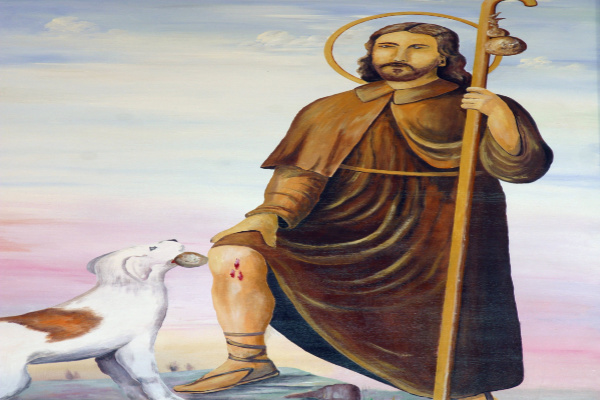August 16th is St. Roch’s Day, or The Feast of St. Roch, celebrating the patron Saint of Dogs. Here’s the story behind the story….
According to The Catholic Company, St. Roch (c.1295 – 1327), also known as St. Rocco, was a nobleman from Montpellier, France, the only son of the wealthy governor of the city. He was born with an unusual and deep red mark on his chest in the shape of a cross, a sign that the Blessed Virgin Mary had heard and answered his mother’s prayers for her barrenness to be healed. As a child, St. Roch was deeply religious, fasting twice a week after the example of his pious mother.
His parents died when he was twenty years of age, after which he gave his inheritance to the poor, handed the government of the city over to his uncle, and began a new life as a poor mendicant pilgrim. Free from all earthly cares, St. Roch joined the Third Order Franciscans, donned the familiar pilgrim’s garb (a common practice of popular piety at the time) and set out on a pilgrimage to visit and pray at the holy places in Rome. When he came upon the town of Acquapendente near Viterbo, he saw that it was badly struck by the black plague which was wreaking havoc across Europe. He sojourned there for a time to care for the sick both in private homes and in the hospitals—at great risk to himself.
Instead of contracting the highly contagious disease, St. Roch cured many people simply by making the Sign of the Cross over them. He continued his charitable work until the disease was halted from spreading further in the village, after which he continued on his pilgrimage. His miraculous healing power evidenced itself in the same manner in every plague-infested town that he passed through on his way to Rome, and in Rome itself. Thus, St. Roch became famous in the region, known for his apparent healing powers.
When his travels brought him to the town of Piacenza, he discovered that he was no longer spared from the deadly disease, having finally contracted it in the leg. Feeling that he was likely doomed to death, instead of burdening anyone with his sickness, St. Roch commended himself to God and awaited his death in a remote and abandoned forest hut. Providentially, a local nobleman’s hunting dog found him alone, frail, and vulnerable. St. Roch fully expected the animal to attack him and end his suffering, but instead, every day the dog returned with food, and stayed by his side to care for him. A spring arose nearby that provided them both with fresh water.
Soon, the nobleman followed his straying pet into the woods to find out what his dog was up to, which led him to discover and aid the holy pilgrim. Slowly St. Roch’s health was restored, after which he received divine inspiration that he should return to his native Montpellier. It is said that this hunting dog healed Roch by licking the wounds the plague created, as wekk as bringing the man food to keep him alive. And so, St. Roch’s affiliation with dogs began.
Once back in Montpellier, St. Roch found the city at war. He refused to disclose his identity to the soldiers so that he could remain poor and unknown, having renounced his former life as the son of the governor. But his obfuscation aroused suspicion. He was accused of being a spy disguised as a pilgrim. St. Roch did not defend himself against these charges—wishing to conceal his true (and noble) identity—and instead entrusted himself completely to God’s will.
He was cast into prison by his own uncle, who failed to recognize his nephew’s altered appearance. According to legend, St. Roch was forgotten and abandoned in prison—but God sent angels to minister to him while he was held in captivity. He died there five years later.
—
Photo Credit: Zvonimir Atletic / Shutterstock.com
